Honor Award
NativeSpec™
Nicholas Serrano, Student ASLA and Brittany Harvey, Student ASLA, Ball State University
Faculty Advisors: Martha Hunt and Bob Koester
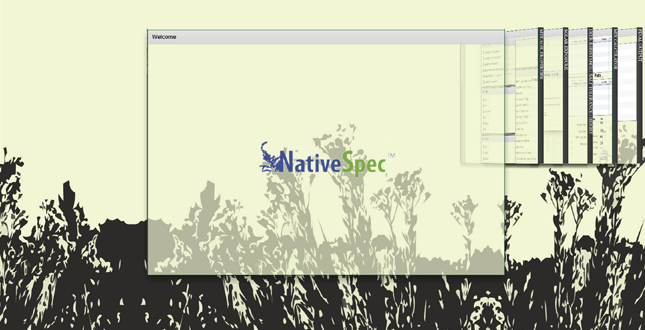 Close Me!
Close Me!NativeSpec™ is designed as a series of information panels which surface from the right and recede to the left as a user moves through the program.
Download Hi-Res ImagePhoto: Nicholas Serrano
Photo 1 of 6
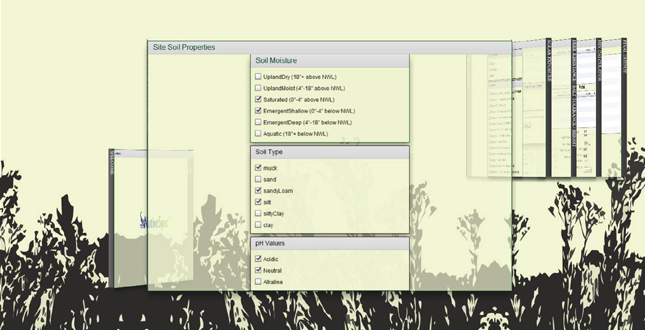 Close Me!
Close Me!Four panels allow a user to input different site characteristics pertaining to soils, sun exposure, height restriction, tolerances, and ecoregions. This information is used to determine which species are viable for a given project.
Download Hi-Res ImagePhoto: Nicholas Serrano
Photo 2 of 6
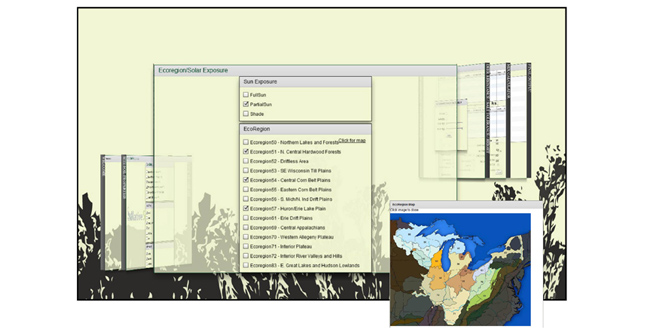 Close Me!
Close Me!NativeSpec™ has the ability to select plants by where they are found growing in the wild. A pop-up map visually orients the user to each ecoregion.
Download Hi-Res ImagePhoto: Nicholas Serrano
Photo 3 of 6
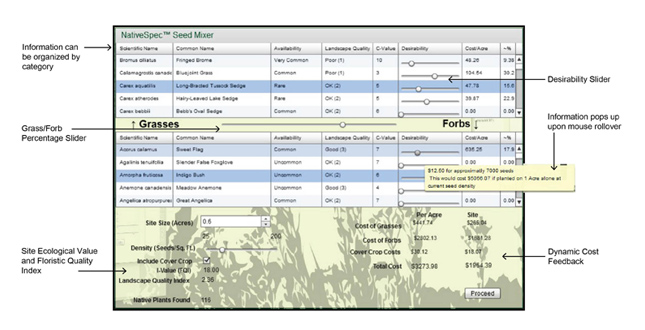 Close Me!
Close Me!In the seed mixer a user specifies quantities of each species with a desirability slider of 0–50. This mixer also includes dynamic information feedback features such as cost, ecological value, and floristic quality that are updated with each change in the mix composition.
Download Hi-Res ImagePhoto: Nicholas Serrano
Photo 4 of 6
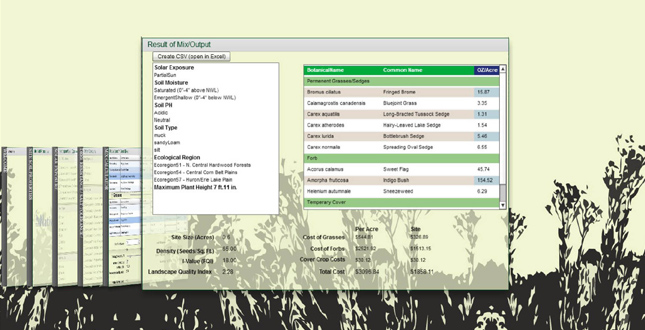 Close Me!
Close Me!NativeSpec™ displays results of the custom seed mix with total cost, mix statistics, plants included, and site characteristics selected. An option to export the data as an Excel file allows the user to download this information.
Download Hi-Res ImagePhoto: Nicholas Serrano
Photo 5 of 6
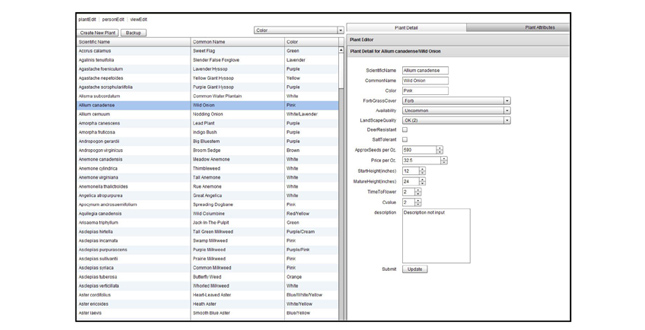 Close Me!
Close Me!PlantEditor™ is a program developed to manage all the data user by NativeSpec™. This is where a user can update the information of each plant, add new plants, change the values of each category, and add new users to the system.
Download Hi-Res ImagePhoto: Nicholas Serrano
Photo 6 of 6
Project Statement
NativeSpec™ is a custom seed specification tool for landscape architects to create seed mixes adapted to specific project criteria.Site environmental characteristics produce a list of viable plants which can be adjusted for species percentages with dynamic feedback on cost implications.This efficiency of information delivery gives designers flexibility and confidence when specifying ecological restoration projects.
Project Narrative
When it comes to specifying plants there is a myriad complex of information and countless plants available for landscape architects to use, yet navigating this sea of resources is often perplexing. How can professionals be sure plants they are using are appropriate? What is the efficient method for sorting through information?
NativeSpec™ provides the solution through innovative information organization. It is a web-based custom seed mix specification tool designed for landscape architects to use in the expanding field of native planting design and ecological restoration. This technological innovation will empower landscape architects by improving the efficiency and availability of information on native plants used in seed mixes.
Context and Problem
In the past thirty years landscape architecture has seen a growing demand for environmentally sound planting designs sensitive to the specific ecological context of each site. For woody trees and shrubs this simply means finding regionally appropriate native species, many of which are produced by local nurseries. However, herbaceous material constitutes a much larger variety of species, all adapted to specific site characteristics and many which overlap in habitat tolerances.
For seed mixes landscape architects have traditionally relied on standard mixes available from native plant nurseries or hiring specialists who build custom mixes. Standard seed mixes are limited in the combinations of site characteristics for which they are adapted, resulting in many plants failing, and therefore customer disappointment. Hiring specialists is often expensive, can result in human error, and relinquishes control of planting decisions to other professionals. NativeSpec™ puts landscape architects back in control of planting decisions aided with the confidence and accuracy of efficient computer database management.
NativeSpec™ Functions
NativeSpec™ functions in two stages, first by eliminating all species unsuitable for a given site and then allowing the user to compose a desirable seed mix. Site specific data on soil properties including soil type (muck-clay), soil moisture (upland dry-aquatic), and soil pH quickly limit which species are suitable for the project. Sun exposure, tolerances (deer/salt/ect.) and any height restrictions further narrow the species list, and there is even an option to choose plants based on ecoregion, or where they are native in the wild.
Once a viable species list has been determined, plants are sent to the Seed Mixer where species are separated in two tables according to grasses and forbs. Information on plant characteristics including name, market availability, landscape quality, and ecological value (c-value) is organized by column allowing the tables to be sorted according to whichever category is desired.
To compose a final seed mix, the user assigns each plant a desirability score from 0-50, 50 being very important to the mix and 0 excluding it altogether. NativeSpec™ figures the percentage a species comprises in the final mix of its plant type (grass or forb) by dividing an individual plants desirability score by the total number of desirability points assigned in the mix. If Liatris spicata has as desirability score of 25 and there are 200 total desirability points assigned to forbs, 12.5% of the forbs mix would be Liatris spicata.
NativeSpec™ has the added ability to adjust the percentage of grasses and forbs in the mix with a sliding scale between the two tables. This feature was added because although forbs are usually more desired for their floristic appeal, they are also much more expensive and one of the quickest ways to reduce project costs is to reduce the percentage of forbs to grasses. The program simply takes all percentages of each plant type and fits this within the percentage of total mix allocated to either grasses or forbs. Users also have the ability to set site acreage and desired seed density in the mixer.
With each individual adjustment in the Seed Mixer the total site cost is updated to give the user real time dynamic feedback on the cost implications of each decision. This allows landscape architects to balance the aesthetic qualities of some species with low cost of others. The landscape quality index (weighted average scale) and i-value (average site ecological value, see Swink and Wilhelm 1994) are also continually updated.
When a desired seed mix has been created the user proceeds to a results page which summarizes the custom seed mix. This includes all site requirements leading to the viable species list, plants included in the final mix, and all mix statistics such as total cost, cost per acre, seed density, i-value, and landscape quality. An option to export this data to an excel file lets the user save this information, send it to the contractor, and include it in construction specs.
NativeSpec™ is a front end application that pulls information from a back end database called PlantEditor™ which manages the plant files and all information associated with them. In PlantEditor™ a system administrator can update plant information, add new plants, alter plant characteristics categories, and manage user access to both systems. As such, PlantEditor™ functions as the content manager while NativeSpec™ takes user input and organizes information catered to each specific project.
Conclusions
In reality, NativeSpec™ is an information processing system. There is no new data involved or scientific breakthroughs found. Rather it is a process, a new technique for using information efficiently and making it available to professionals while reducing the possibility of human error. By allowing landscape architects to create customized seed mixes, NativeSpec™ provides the tools necessary to advance the practice of native planting design and ecological restoration within the profession of landscape architecture. Each seed mix is built in response to specific site characteristics ensuring the greatest probability of planting success. The program further gives designers the ability to weigh costs with floristic attributes, therefore giving them more flexibility in tightening budgets.
Although currently developed for a specific region, it has the ability to expand and include all territories of North America and eventually the world. Furthermore, the framework established in this prototype can be built upon to include more information, new plant characteristic categories, and thereby leading the way to new developments in the profession.
Swink, Floyd and Gerould Wilhelm. 1994. Plants of the Chicago Region, 4th edition. Indiana Academy of Sciences
Additional Project Credits
Additional Team Members
Elizabeth Marthaler
Caroline Weidman
Saul Jones
George Keller
Software Developer
Chris Turvey
Project Advisor
Kelli Huth
JFNew VP of Strategy & Marketing
Sam Miller





